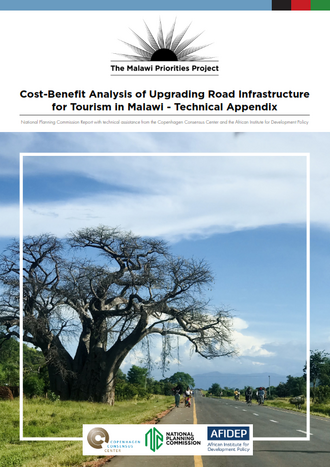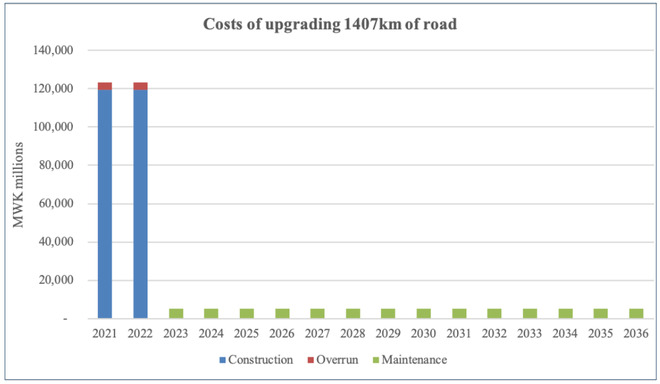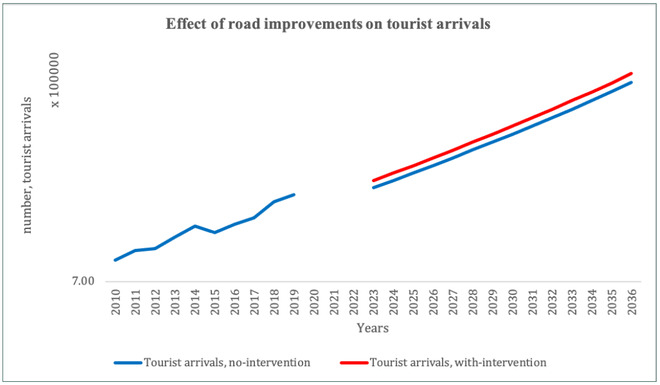Malawi Priorities: Transport
Technical Report
Key Messages
 The Malawi Vision 2063 targets a 100% increase in tourism in terms of its contribution to GDP, from its current baseline of 7.7% to 14.4% in 2040. According to the AFDB (2017), compared to other countries in the Southern African (SADC) region, Malawi lags behind in tourism receipts and tourism supported infrastructure ranked 10th out of 14 countries in tourism arrivals One of the keys to unlocking Malawi’s potential in tourism is an investment in passenger transport infrastructure. Only 30% of Malawi’s 15,451km road network is paved, and transport costs in Malawi are among the highest in the region. Studies have shown that transport is the largest cost contributor (26% of expenditure) associated with game viewing and excursions.
The Malawi Vision 2063 targets a 100% increase in tourism in terms of its contribution to GDP, from its current baseline of 7.7% to 14.4% in 2040. According to the AFDB (2017), compared to other countries in the Southern African (SADC) region, Malawi lags behind in tourism receipts and tourism supported infrastructure ranked 10th out of 14 countries in tourism arrivals One of the keys to unlocking Malawi’s potential in tourism is an investment in passenger transport infrastructure. Only 30% of Malawi’s 15,451km road network is paved, and transport costs in Malawi are among the highest in the region. Studies have shown that transport is the largest cost contributor (26% of expenditure) associated with game viewing and excursions.- Upgrading and paving 1407km of road to key tourist sites would cost MWK 123,135 million in upfront costs plus ongoing maintenance costs of MWK 5,258 million. This would generate substantial benefits increasing international tourism arrivals, reducing vehicle operating costs by 24%, and reducing the time of travel by 56%. Tourism arrivals are expected to increase by 15,500 arrivals initially, with two-thirds coming from Europe / the US, generating benefits in the range of MWK 9,632 – 12,045 million annually while time savings benefits yield an average of MWK 7,325 million annually. However, the largest benefit comes from avoided vehicle operating costs estimated at MWK 79,244 million per year. The benefits average 0.9% of projected GDP from construction to 2036. For every kwacha invested in these roads, Malawi receives 2.8 kwacha in economic benefits.
- The study also demonstrates the importance of ensuring a sufficient maintenance budget. Currently, budget allocations for road maintenance are only 22% of the need. Conducting annual routine maintenance on this 1407km of road, once it is built, would ensure the above economic benefits are sustained and avoid substantial reconstruction costs. The cost to fill the routine maintenance gap on the 1407km of road is only MWK 4,133 million per year, and this would avoid large reconstruction costs estimated at MWK 64,528 million in 2029 and 2036. For every kwacha invested in road maintenance, the return on investment is 5.2.
- The implication of the analysis is that ensuring paved roads can provide significant benefits to the Malawian economy. The intervention will increase international tourism receipts by 30%. A portfolio of complementary investments, which includes road upgrading, is required to double the tourism share of GDP by 2040.
Context
Tourism contributes 7.7% to Malawi’s GDP, and sub-optimal capacity utilization of tourism facilities and services indicates that there is an opportunity for growth. One of the keys to unlocking Malawi’s potential in tourism and other sectors like mining and forestry is an investment in passenger transport infrastructure. Due to the fact that it is landlocked, transport costs in Malawi are among the highest in the region. Furthermore, road infrastructure is poor and below internationally accepted standards. Earlier analyses, as in Magombo (2011), cite the poor conditions of roads as being impediments to attracting more international visitors. In fact, some of the key tourist attractions were deemed inaccessible due to road conditions in Magombo’s review of post-independence tourism planning. The Ministry of Tourism in 2007 attempted to address this by upgrading the access roads to certain resort areas.
To address this challenge, the Government of Malawi is aiming to mainstream tourism in the transport sector by ensuring the provision of appropriate infrastructure to support the sector (National Tourism Policy, 2019). Malawi has 15,451 km of the road network (National Transport Master Plan), and only 30% are paved (Malawi Vision 2063). The country faces high transport costs. A World Bank value-chain analysis found that transport costs are often the highest single cost category (26% of total expenditures), especially when including transfers and moving guests on excursions and game viewing. The costs include capital costs of vehicles for transfers, vehicles, and boats for game viewing and excursions, maintenance costs, and fuel. Poor quality roads increase maintenance bills and decrease the average operational lifespan of vehicles (World Bank, 2010). The NTMP cites the costs of oil, time spent at border crossings, and road quality as the main cost drivers.
This paper focuses on cost-benefit analysis of upgrading certain sections of the road network to and around strategic tourist sites, totaling 1407 kilometers. A supplementary analysis is also included to demonstrate the value of ensuring continued maintenance.
Upgrading 1407km of the road network would generate significant economic benefits for Malawi
Given the critical role of road infrastructure in realizing the potential of selected tourist hubs, the study undertakes a cost-benefit analysis of upgrading of 1407 kilometers of mostly rural roads. These roads have been identified by the Malawi-NTMP (2018) as being essential to the development of certain tourist attractions. Tourism and the related services in these areas will be affected by the road upgrades as also other economic sectors, for which transport is both an essential and costly component. The proposed upgrading of 1407 kilometers of the road represents approximately 9% of the total network (paved and unpaved) and would increase the % of paved roads by 9pp, a 30% increase on current levels.
The cost of upgrading 1407km of road to key tourist sites would cost MWK 123,135 million in upfront costs in the first two years plus ongoing annual maintenance costs of MWK 5,258 million. A marginal cost overrun associated with delays is also factored in at MWK 3,639 million for the first two years. The benefits of the proposed road works include an increase in tourism revenues, a reduction in travel times and vehicle operating costs (VOC) of existing users, and the consumer surplus of induced demand.
The intervention will stimulate over 15,462 additional tourist arrivals in 2023, reaching 19,336 in 2036. Correspondingly, receipts begin at MWK 9,632 million in 2023 and reach MWK 12,045 million in 2036. It would lead to time savings of about 29.5 million hours per year across the 1407km road network equivalent to MWK 6,054 million in 2023 and growing to MWK 8,782 million by 2036. It would also reduce the vehicle operating costs of existing users resulting in the savings of MWK 79,244 million annually. Another benefit is the consumer surplus of induced demand, with road improvement expected to attract new (domestic) users valued at MWK 3,021 million in the first year, rising to MWK 3,787 million. In total, the benefits equal MWK 97,951 million in 2023 and rise to MWK 103,858 million in 2036. Eighty percent of the benefits are due to vehicle operating costs.
The intervention has a central BCR of 2.8 providing benefits higher than costs which are relatively large in absolute terms, equal to 0.9% of projected GDP until 2036. However, meeting the aim of doubling Malawi’s tourism share of GDP will require a larger suite of investments than just paved roads.
Reconstruction of paved roads becomes necessary when periodic maintenance and rehabilitation activities are neglected. Sub-optimal allocations to the road maintenance fund have resulted in gradual declines of the road network classified as ‘good’, necessitating the complete reconstruction of roads. We also demonstrate the importance of regular maintenance by conducting a supplementary cost-benefit analysis on meeting regular maintenance needs, conditional on the road already being built. The cost of regular maintenance of the newly asphalted 1407 kilometers was compared to the benefits of avoided future reconstruction costs. The benefit-cost ratio is 5.2, meaning that for every kwacha spent on regular maintenance there are 5.2 kwacha saved in avoided reconstruction costs and deterioration of benefits.
Figure 1: Costs of upgrading 1407km of road

Figure 2: Effect of road improvements on tourist arrivals

Figure 3: Benefits from upgrading 1407km of the road network

Summary Table
| Intervention | BCR | Costs | Benefits |
|---|---|---|---|
| Upgrade and pave 1047km of roads around select tourist sites | 2.8 Fair (100% economic benefits) | MWK 123,135 million for construction over 2 years MWK 5,258 million per year for maintenance |
Benefits in 2023: MWK 79,244 million - 24% reduction in vehicle operating costs MWK 6,054 million – 56% reduction in travel time MWK 9,632 million – 15,460 extra tourist arrivals MWK 3,021 million – benefits from increased road use Total benefits 2023 to 2036: MWK 97,951 million in 2023, rising to MWK 103,858 million in 2036 |
| Fully financed road maintenance | 5.2 Good (100% economic benefits) | MWK 4,133 million per year to fill the maintenance gap | MWK 64,528 million Avoided reconstruction cost of roads in 2029 and 2036 MWK 3,778 to MWK 28,042 million sustained benefits from road upgrading |
Note: BCRs are based on costs and benefits discounted at 8% (see accompanying technical report). BCR ratings are determined on the following scale Excellent, BCR > 15; Good, BCR 5-15; Fair, BCR 1-5; Poor, BCR < 1. This traffic light scale was developed by an Eminent Panel including several Nobel Laureate economists for a previous Copenhagen Consensus project that assessed the Sustainable Development Goals.
Download the full policy brief here.

